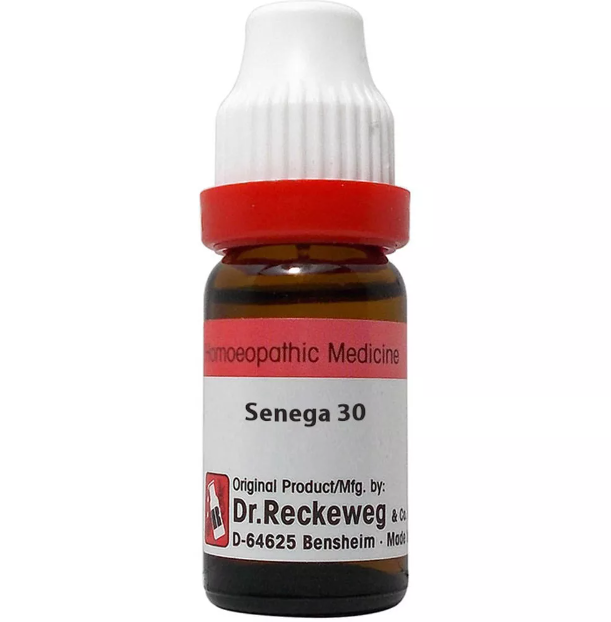SENEGA Q, 6C, 12C, 30C, 200C, 1M, 10M USES AND SYMPTOMS
 SENEGA
SENEGA
Seneg.
Key symptoms include respiratory tract catarrh and distinct paralytic eye symptoms. There are also circumscribed chest spots from past inflammations.
Mind: Remembers trivial things from long ago suddenly; prone to quarrels.
Head: Dullness with pressure and weakness in the eyes; pain in the temples; bursting pain in the forehead.
Eyes: Hyperphoria, improved by bending the head back; affects the rectus superior. Blepharitis; dry, crusty lids (Graph.). Sensation of eyes being too large for orbits. Staring, lacrimation, flickering; frequent wiping needed. Objects appear shaded (amblyopia). Muscular asthenopia (Caust.). Diplopia, improved by bending head back. Opacities in vitreous humor; aids absorption of lens fragments post-operation.
Nose: Dryness, watery mucus, sneezing. Nostrils feel peppery.
Face: Left-sided facial paralysis. Heat and burning vesicles at the mouth corners and lips.
Throat: Catarrhal inflammation with scraping hoarseness, burning, and rawness. Feels as if membrane is abraded.
Urinary: Significantly reduced output; contains shreds and mucus; scalding before and after urination. Bursting pain in the kidney region (nephritis).
Respiratory: Hoarseness, pain while talking. Bursting pain in back when coughing. Catarrh of larynx. Aphonia, hacking cough. Thorax feels narrow, cough may end in a sneeze. Chest rattling, oppressed feeling on ascent. Bronchial catarrh with sore chest walls, profuse mucus, oppression, and weight (pneumonia). Difficulty in expelling tough mucus in the elderly. Asthenic bronchitis in chronic nephritis or emphysema. Asthmatics with congestive attacks. Pleurisy with exudations, hydrothorax. Pressure on chest as if lungs were pushed back to spine. Unsteady voice, partially paralyzed vocal cords.
Modalities: Worse walking in the open air or during rest; better from sweating or bending the head backward.
Relationship: Compare with Caust., Phos., Saponin., Ammc., Calc., Nepeta cataria (for colds, infantile colic, hysteria).
Dose: Tincture to thirtieth potency.
SYMPTOMS OF SENEGA
Mind:
Sudden recollection of trivial past details.
Prone to quarrels.
Head:
Dullness, pressure, and weakness in the eyes.
Pain in the temples and intense pain in the forehead.
Eyes:
Hyperphoria, improved by tilting head backward.
Affects the superior rectus muscle.
Blepharitis with dry, crusty lids.
Dryness with sensation of eyes being too large for the orbits.
Staring, frequent tearing, and need to wipe eyes.
Objects appear shaded (amblyopia).
Muscular asthenopia.
Diplopia, improved by tilting head backward.
Opacities in the vitreous humor.
Helps absorb lens fragments post-surgery.
Nose:
Dryness with profuse watery mucus and sneezing.
Nostrils feel peppery.
Face:
Paralysis on the left side of the face.
Heat and burning vesicles at the mouth corners.
Throat:
Catarrhal inflammation with scraping hoarseness.
Burning and raw sensation as if the membrane were abraded.
Urinary:
Greatly diminished urine with shreds and mucus.
Scalding before and after urination.
Bursting pain in the back, especially in the kidney region (nephritis).
Respiratory:
Hoarseness, pain while talking.
Bursting pain in the back on coughing.
Catarrh of the larynx.
Aphonia (loss of voice).
Hacking cough.
Thorax feels too narrow.
Cough may end in a sneeze.
Rattling in the chest.
Oppression on ascending.
Bronchial catarrh with sore chest walls, profuse mucus, and a sensation of oppression and weight (pneumonia).
Difficulty raising tough, profuse mucus, especially in the elderly.
Asthenic bronchitis in those with chronic nephritis or emphysema.
Asthmatic attacks with congestion.
Exudations in the pleura (pleurisy).
Hydrothorax.
Pressure on the chest as if the lungs were pushed back to the spine.
Unsteady voice with partially paralyzed vocal cords.
Modalities:
Worse in open air, during rest.
Better from sweating and tilting head backward.
selection of the potency
Individualization:
- Homeopathy is based on the principle of treating the individual, not just the disease. The unique symptoms and characteristics of the person are crucial in determining the most suitable potency.
Intensity of Symptoms:
- The intensity of the symptoms guides the choice of potency. If the symptoms are intense and acute, a lower potency (e.g., 6C, 30C) might be considered. For chronic conditions with less intensity, higher potencies (e.g., 200C, 1M) may be appropriate.
Sensitivity of the Patient:
- Some individuals are more sensitive to homeopathic remedies, while others may require higher potencies. The practitioner considers the patient’s sensitivity when selecting the potency.
Acute vs. Chronic Conditions:
- Lower potencies are often used for acute conditions, while higher potencies may be considered for chronic or long-standing issues.
Previous Response to Potencies:
- The patient’s response to previous homeopathic treatments helps guide the choice of potency. If a particular potency has been effective in the past, it may be repeated or adjusted as needed.
Vital Force and Susceptibility:
- Homeopathy views illness as a disturbance in the vital force. The practitioner assesses the patient’s overall vitality and susceptibility to determine the appropriate potency.
Aggravation or Amelioration:
- The direction of the symptom response (aggravation or amelioration) after taking a remedy can influence the choice of potency.
Miasmatic Considerations:
- In classical homeopathy, the concept of miasms (inherited disease tendencies) is considered. The practitioner take this into account when selecting the potency.
Practitioner Experience:
- The experience and preference of the homeopathic practitioner play a role. Some practitioners may have success with certain potencies based on their clinical experience.
SAFETY INFORMATION
- Do not exceed the recommended dose by physician
- Keep out of the reach of children
- Store in a cool dry place away from direct sunlight
- Maintain half an hour gap between food/drink/any other medicines and homoeopathic medicine
- Avoid any strong smell in the mouth while taking medicine e.g. camphor, garlic, onion, coffee, hing
Medicine images use for reference only selection of homeopathic medicine depends on the individual’s specific symptoms and overall constitution. Moreover, homeopathy is a holistic system of medicine that treats the individual as a whole. In addition to addressing the physical symptoms, it takes into account the emotional and mental state of the person. Consequently, it’s crucial to consult with a qualified homeopathic practitioner for personalized treatment.
The information provided on this website is intended solely for educational purposes. Always seek the advice of your physician or other qualified health provider.
